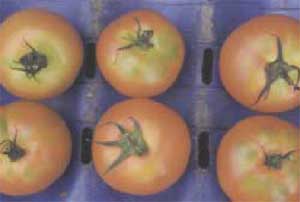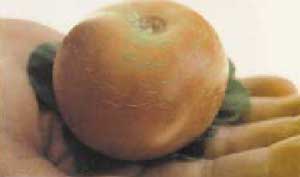Green
Shoulders
 Zvi Howard Wener is well know to farmers in Australia and New Zealand,
and as an online crop consultant can be contacted through
www.agrisupportonline.com Zvi Howard Wener is well know to farmers in Australia and New Zealand,
and as an online crop consultant can be contacted through
www.agrisupportonline.com
What are persistent
green/yellow shoulders?
This phenomena occurs when tomato varieties with
green shoulders undergo ripening but the shoulders remain dark green
or turn to yellow but do not turn to red.
When does this happen?
This phenomena, can take place when the temperature
of the fruit becomes very high. These high temperatures can result
from the fruit being exposed to the sun during the stages of
ripening. Frequently, when tomatoes are grown in very high
temperatures, unexposed fruit can simply heat up and this phenomena
will also occur.

Why
does this happen?
The chlorophyll in the green shoulder of
the fruit is slow to break down during the ripening phase. The
result is a patch that can remain green and may turn to yellow but
will not turn to red. This happens on fruit that has been exposed to
high temperatures during maturation and ripening.
Control
1. When fruit is picked green and ripened in
the dark there is no problem with the shoulders. If the problem is
great then the tomatoes may be picked as mature greens and ethylene
ripened in the dark.
2. Use varieties that are
resistant to this phenomena, either with or without green
shoulders.
3. Avoid causing the fruit to
be exposed unnecessarily to the sun. Proper nutrition, pruning and
de-leafing are the best protection against persistent green/yellow
shoulders. The leaves protect the fruit from the sun and help create
a favourable microclimate. Leaves should only be removed when it is
necessary to facilitate the picking. |
|
Russeting
Symptoms:
It is the appearance on the skin of the
fruit of a number of small cracks which are often concentric.

Causes:
1.
When chemical sprays are applied in excessive quantities or under
poor conditions, the cuticle can become more corky and as a result,
less elastic. As the fruits grow, the cells are not elastic enough
and small cracks start to appear.
2. Large variations in temperature, when
daytime temperatures are high (accompanied by relatively low
humidities) and night temperatures are low. The cuticle cells are
not elastic enough to cope with the changes.
3. Poor light intensity in the greenhouse
caused by cloudy weather or even excessive shading with nets,
whitewash or thermal screens.
4. Low levels of Electrical Conductivity
(EC) around the root system.
5. Sensitivity varies with different
varieties.
Control:
1. Use proper chemical
concentrations when spraying crops. Spray only under proper
conditions. Use the correct equipment.
2. Use proper water management to control
growth; water at fixed intervals and reduce when necessary.
3. Apply a good fertilizer programme to
avoid overly succulent plants.
4. Keep leaves healthy for as long as
possible by properly managing diseases and by supplying adequate
fertilizers.
5. Do not excessively remove leaves. Leaves
create a micro-climate for the fruit which helps prevent russeting.
6. Use varieties that may be more resistant
to russeting. |